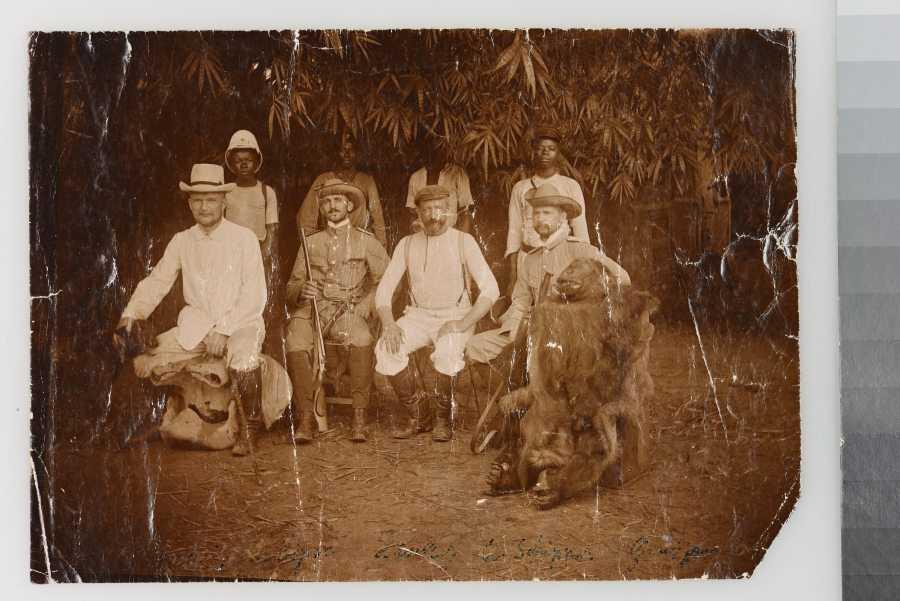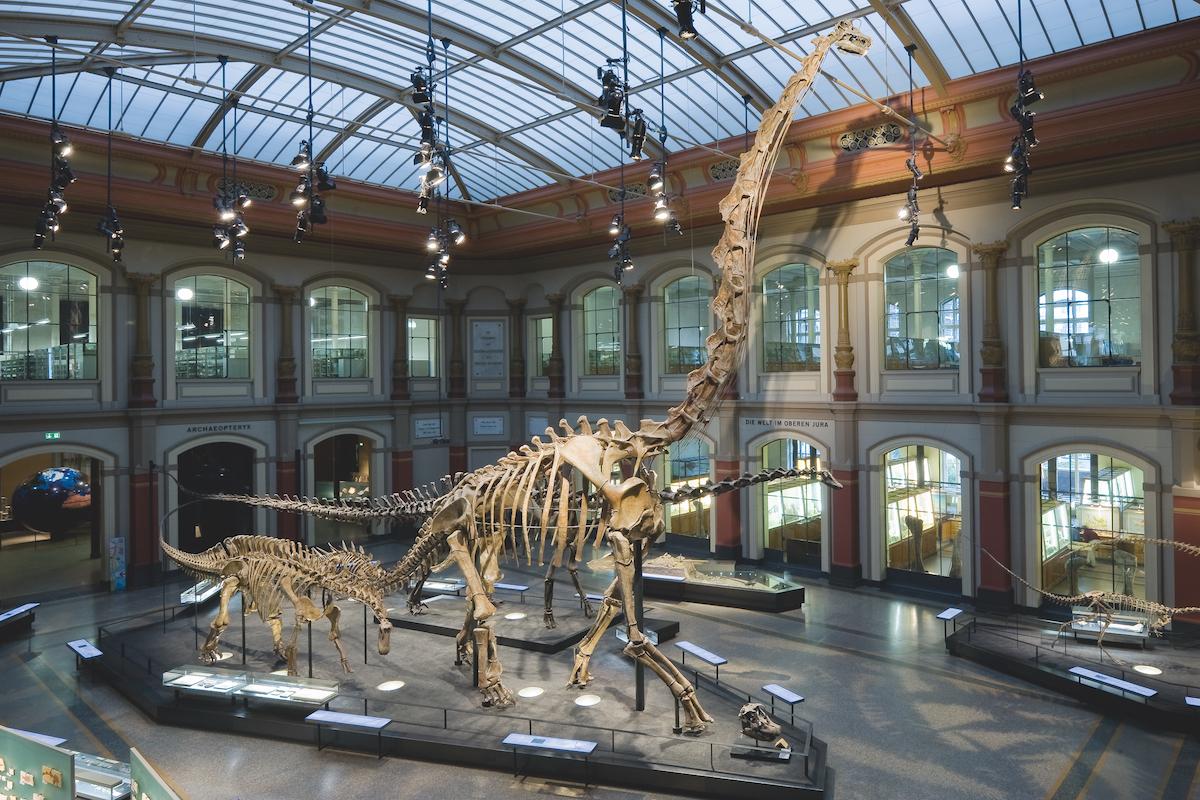The Museum für Naturkunde Berlin critically reflects its historical responsibility
New cooperation: TheMuseumsLab – a platform for joint learning, exchange and continuing education regarding the future of museums in Africa and Europe
The establishment of natural history museums and collections in Europe was inextricably linked to colonial expansion since the end of the 15th century. Scientific, economic and political motives were closely intertwined. The goal of natural history collecting was to describe the diversity of flora and fauna as well as minerals, based on as many objects as possible and to arrange them according to Western ideas. At the same time, the exploration of natural resources in the colonised territories assisted in their economic exploitation.
The Museum für Naturkunde Berlin is exemplary for these colonial entanglements: Since its foundation in 1810 it received collections from all over the world. These objects complemented the already existing collections from the Kunstkammer, the Prussian Academy of Sciences as well as the Bergakademie. Here, as in all other major Western natural history museums, collections from colonial contexts continue to form a significant basis for research and exhibitions.
At the Museum für Naturkunde Berlin we use an interdisciplinary approach to examine the history of the institution and the collection with a strong focus on collections from colonial contexts. By colonial contexts we mean formal colonial rule as well as those historical and contemporary structures with asymmetrical power relations. Our work currently prioritises collections from areas that were once part of the German colonial empire. In addition, we look at earlier colonial and racist structures which had an impact beyond the colonial period. In this respect, and in addition to the history of the institution and its collection, we are reexamining contemporary scholarly practices, language and shared values. The aim is to initiate reflection and transformation and to open up the collection to a global dialogue.
German colonial rule and the Museum für Naturkunde Berlin
Especially in the period from 1884 to 1919, the Zoological Museum of today's Museum für Naturkunde played a prominent role in centralising and analysing the collections from the German colonies in Africa, the Pacific, and China. The Museum initiated a large number of expeditions and provided colonial officials and military personnel in the colonies with basic knowledge in natural history collecting as well as with collecting instructions and materials.

Georg Zenker (front row, 3rd from the left) is a prominent example of the widespread practice of transdisciplinary collecting in colonial contexts: in addition to his work as a colonial officer and plantation owner in the then German colony of Cameroon, he collected many zoological, botanical and ethnological objects, which he sent to Berlin to the Museum für Naturkunde, the Ethnological Museum and the Botanical Museum.
Due to the Federal Council decision of 1889 the Museum was the recipient of all objects from expeditions funded by the German Reich, as well as the materials collected by colonial officials. The collections grew to an unprecedented extent, especially due to the objects received from the then German colonies. The Jurassic fossils from Mount Tendaguru in what was then German East Africa, modern-day Tanzania, achieved particular prominence and have been on display in the museum's dinosaur hall since 1937. But even less prominent collections benefited from colonial domination and infrastructures.
Even after the end of German colonial rule in 1919, the territories which continued to be colonised, remained important reference points for collecting and research activities at the Museum für Naturkunde. In this respect, researching the collection history of the Museum's approximately 30 million objects presents us with immense challenges.
The Humanities of Nature at the Museum für Naturkunde is dedicated to researching this history. Currently, the following projects examine colonial provenances:
- Colonial Provenances of Nature. The Expansion of the Mammal Collection around 1900
- Guidelines on Dealing with Natural History Collections from Colonial Contexts
- Provenance research under the spotlight
- Fossil Heritage Tanzania
In addition, the following projects also deal with colonial provenances and the coloniality of natural history collections.
- A Window on Nature and Art. A Historical Study of the Brandenburg-Prussian Kunstkammer (2019-2022)
- Animals as Objects. Zoological Gardens and Natural History Museum Berlin, 1810 bis 2020 (2019-2021)
- Museums and Society. Mapping the Social (2021-2023)
The collaborative project Dinosaurs in Berlin. Brachiosaurus brancai as an Icon of Politics, Science, and Popular Culture (2015‒2018) dealt with the most prominent colonial object from the Museum’s collection, Giraffatitan brancai, unearthed during a paleontological expedition in what was then German East Africa, modern-day Tanzania. The results of this research on the political and scientific contexts and public presentation of these remarkable paleontological objects were published in the volume Dinosaurierfragmente. Zur Geschichte der Tendaguru-Expedition und ihrer Objekte, 1906-2018.
The series of international conferences on the topic of natural history and colonialism includes, for example:
- Working on Things. On the social, political, economic history of collections (2016)
- Politics of Natural History. How to decolonise the Natural History Museums (2018)
In addition to public events, central aspects of this debate are internal workshops on the colonial institutional and collection history of the Museum für Naturkunde, but also on continuing colonial structures and racism.
Further discussion as well as guided tour programmes are being developed that deal specifically with the museum's colonial history.
The Museum für Naturkunde is also taking part in the pilot phase within the framework of the 3-Roads-Strategy for the Documentation and Digital Publication of Collections from Colonial Contexts held in Germany. First results can be found here.
For questions, suggestions and requests for cooperation, please contact: humanities@mfn.berlin
Cited Literature and further reading
Archival:
- HBSB, Zoolog. Museum S I, Frühe Kataloge, Mappe 6 Eingangskatalog (1816‒1828)
- Bestand Säugetierkustodie
Angermann, Renate, Die Säugetierkollektion des Museums für Naturkunde der Humboldt- Universität zu Berlin, in: Säugetierkd. Inf. 3 (1989), H. 13, S. 47‒68.
Bericht aus dem Zoologischen Museum in Berlin im Rechnungsjahr 1915, in: Mitt. Zool. Mus. Berl. (1916), S. 241‒255.
Brauer, August, Das Zoologische Museum, in: Geschichte der Königlichen Friedrich-Wilhelms-Universität zu Berlin, hrsg. von Max Lenz, S. 372‒388.
Bruchwitz, Arend, Koloniale Sammelpraktiken zwischen Kamerun und Berlin ‒ Die Säugetierkustodie des Museums für Naturkunde 1889‒1916, Masterarbeit HU-Berlin 2019.
Gissibl, Bernhard, The Nature of German Imperialism. Conservation and the Politics of Wildlife in Colonial East Africa, New York 2016.
Heumann, Ina, Stoecker, Holger, Tamborini, Marco, Vennen, Mareike, Dinosaurierfragmente. Zur Geschichte der Tendaguru-Expedition und ihrer Objekte 1906–2018, Göttingen 2018.
Kaiser, Katja, Sammelpraxis und Sammlungspolitik. Das Beispiel Georg Zenker, in: Rahemipour, Patricia (Hrsg.), Bipindi – Berlin. Ein wissenschaftshistorischer und künstlerischer Beitrag zur Kolonialgeschichte des Sammelns (= KOSMOS Berlin – Forschungsperspektive Sammlungen, Bd. 1), Berlin 2018, S. 7-46.
Köstering, Susanne, Natur zum Anschauen. Das Naturkundemuseum des deutschen Kaiserreichs 1871–1914, Köln 2003.
Kretschmann, Carsten, Räume öffnen sich. Naturhistorische Museen im Deutschland des 19. Jahrhunderts, Berlin 2006.
Liebisch, Das geologisch-paläontologische Institut und Museum, in: Geschichte der Königlichen Friedrich-Wilhelms-Universität zu Berlin, hrsg. von Max Lenz, Halle 1910, S. 310‒319 .
Heinrich Lichtenstein, Das Zoologische Museum der Universität zu Berlin, Berlin 1816.
Miehlbradt, Sandra, Von königlichen Audienzen, stillen Helfern und Jagdtrophäen. Das Sammeln naturkundlicher Objekte für das Museum für Naturkunde im kolonialen Kontext, in: Brogatio, Heinz Peter/Röschner, Mathias (Hg.): Koloniale Spuren in den Archiven der Leibniz-Gemeinschaft, Halle 2020, S. 12‒23.
Nyhart, Lynn K., Modern Nature. The Rise of the Biological Perspective in Germany, Chicago 2009.
Pappenheim, Paul, Bericht über das Zoologische Museum der Universität Berlin in den Jahren 1916-1926, Berlin 1928.
Stoecker, Holger, Ein afrikanischer Dinosaurier in Berlin. Der Brachiosaurus brancai als deutscher und tansanischer Erinnerungsort, in: WerkstattGeschichte, Nr. 77 (2018): S. 65–83.
Uhlig, Manfred/Jaeger, Bernd, Zur Erforschung der Käferfauna der afrotropischen Region durch das Museum für Naturkunde Berlin mit einem Überblick über die coleopterologischen Ergebnisse der ersten gemeinsamen Expedition des Museums für Naturkunde Berlin und des State Museum Windhoek in Namibia, in Mitt. Zool. Mus. Berl. 71 (1995), 2, S. 213‒245.
